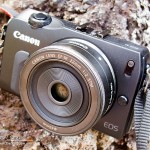DSLR cameras have been the design of choice for professional and serious amateur photographers for over a decade, ever since the era of digital photography began. Big lenses and big sensors made the most of what light was available offering the best possible photographic performance. This performance is a huge jump over what the smaller lenses and sensors of compact cameras offer. A performance gain that makes carrying such a large camera worthwhile.
A DSLR is big because of the demands of the available technology. The swinging mirror directs light into optical viewfinders and phase detection focus sensors. Over the last couple years a new type of camera has appeared, taking advantage of advances in technology to dispense with the bulky swinging mirror design. Fast, high resolution electronic viewfinders and better focus technology allow this transformation. Engineers can create a camera far smaller while keeping the large sensor and interchangeable lens. Better yet, getting the lens closer to the image sensor allows a smaller, lighter, less expensive lens without sacrificing performance. Enter a new paradigm of camera that offers much of the performance of a DSLR in a compact design.

I have been awaiting the new Canon EOS-M for some time. Announced in July 2012, the initial specifications looked pretty good. An APS-C sized sensor, larger than many of the competing systems, promises good low light performance and opportunities for astrophotography. Reading through the specifications I liked what I saw. Here is a camera that should provide much of the performance of a DSLR in a compact, very convenient form factor. I placed a camera on pre-order within a day of the announcement.
I had to wait about four months for the actual hardware to become available. I am not usually an early adopter, but I was ready to make an exception for this camera, something very uncharacteristic for me. It was a pleasant surprise when I finally received shipment notification just last week, on the 13th of November. I was finally going to get my hands on what I had been reading about.
I wanted this camera for several specific roles. First was to have a carry camera that offered fewer limitations than the G series I have generally used for day-to-day shooting. Too often I have been faced with a shooting situation that the compact just could not do. I have tried to carry the 60D more often, but the size of the camera is an issue.
I wanted to use the camera for astrophotography, another camera that can be used in parallel with the 20Da or 60D. You can put more than one camera on the mount and shoot. With exposures running to hours this can dramatically increase the amount of material you can produce in a night of shooting.
Because the camera has almost no back-focal distance, the distance from the lens mount to the detector, it is possible to mount a number of very interesting optics to the camera. Old lenses, telescopes and more. This is one feature I was really looking forward to. I have some great old Canon FD lenses, fish-eye lenses, and more that should work with a mirror-less design. It is just a matter of buying a third party adapter, or machining my own to adapt the new camera to experimental optics. This sort of camera body should be fun.
Unpacking a new camera is a rare joy. A bit of ceremony, beginning to learn a new tool that I expect will be part of my life for a number of productive years. The build quality on the EOS-M is impressive. Holding the EOS-M for the first time is enjoyable. The camera feels good in the hand. A solid metal body, wonderful feel in the controls, the lens mounts smoothly and firmly. Everything about the physical experience was fulfilling my expectations.
This is one of the only cameras I have had to read much of the manual for. The interface is notably different than the previous Canon cameras I regularly use. All of the functions I expect are there, I just have to find them. One reason for this is to learn the iconography used on the controls and LCD screen, there are quite a few symbols for which the meaning is not immediately clear. For example, the main mode dial on the top of the body has an A+ in a box as one of the settings. The manual identifies this as “Scene Intelligent Auto”. While I guessed this was some automatic mode, I need to really understand what this mode entails. The entire interface depends heavily on knowing these symbols and some effort must be expended to become proficient.
There are also quite a few novel features. The touch screen centric interface takes some getting used to. The screen is a capacitive technology, similar to what is used in smart phones and tablets. It is snappy, quite responsive and accurate. Most of the controls are also available through using the buttons, but I expect that the screen would be my preferred method of controlling the camera.
The camera does have a couple negative points… The screen does not flip-out, swivel or tilt. Having this feature on both my 60D and G12 is really nice. The screen is a capacitive touch screen, I suspect the electrical interface to the touch screen made it difficult to include the mechanical knuckle necessary to swivel the screen. The permanently mounted screen can also be a bit larger, bigger being better in such a screen oriented design.

Using the touch screen to choose the focus point is quite convenient. Simply tap on the screen where you wish to focus and the camera refocuses and takes the shot. Another place where the touch screen interface works well and offers a powerful feature.
The camera does have a tendency to blow out the highlights when shooting in JPG and full auto. I have the raw images downloaded, but have not yet opened them, the EOS-M raw format is yet to be supported in the latest Photoshop raw plugin. Is highlight control adjustable? Hmmm, have to hit the manual again.
I only noticed something truly wrong when I loaded up the latest version of the EOS Utility and hooked the camera to the computer. The button from remote control of the camera did not appear. What!?! I unplugged and replugged the camera, I restarted the software, no remote control? I plugged in my EOS 60D, no problem, I was able to run the camera remotely and take images. Plug the EOS-M back in and nothing. We have a problem!
I went back online an examined the camera specifications on the Canon USA site and on the B&H site, did I miss something? No. There is no indication that this EOS camera did not allow the full features of the EOS Utility like any other Canon EOS camera out there. A little more searching showed a number of discussions on forums and secondhand info from Canon that indicated the camera would support remote shooting. This changes in the last few days with others coming to the same realization. Canon has deliberately crippled the firmware and removed the feature! I expect that the Canon engineers have done their jobs and built a good camera, only to have their work sabotaged by the marketroids.
This revelation comes too late. It is only in the last few days that conformation of this feature (or lack thereof) has appeared. Long after I ordered the camera and just about the time mine shipped from B&H Photo. So much for being an early adopter!
It is the lack of tethered shooting that is the deal breaker for me. Without this feature the camera is useless for many of the tasks for which I purchased it. Setting the camera up to do a timelapse would be difficult, the IR shutter release the only way to automatically trigger the camera. There is no point in attaching it to a telescope, I will not be able to set the camera to perform a series of exposures as needed for astrophotography.
I have already requested the return authorization from B&H and the camera has been packed back into the box for return. I love the platform, there is real promise here. I really hope that Canon decides to do the right thing and reconsider the decision to cripple this camera.







That’s too bad.
I wonder why Canon did that?
It seems like both Canon and Nikon have dropped the ball on with their mirrorless cameras.
Hi Andrew. I’ve read your review here with interest as I’m considering an EOS-M myself. It’s really too bad that Canon has essentially crippled it because the remote triggering options are so limited. Though, I’m still considering it as a walking around camera and keeping my 5D as a time lapse and astro shooter.
Your comment about the focusing speed did worry me though. What lens did you try that with? I read the dpreview article on the camera and they suggested it might be the 22mm lens at fault:
http://www.dpreview.com/previews/canon-eos-m/
“on first impressions the 18-55mm focuses pretty quickly, the 22mm is distinctly slower. This is not totally surprising given that the entire optical unit racks back and forth for focusing; this is not a design approach that’s ever been associated with ultra-fast focusing on this type of lens.”
Did you try focusing with a regular EF lens using the adapter? I’d be curious to know if the focusing slowness is limited to that lens.
-Josh
I only used the 22mm pancake and the telescope, not any other lens, even though I did have the adapter available. I might have missed that comment in the dpreview review!
Hi! I just ordered the EOS-M and 22mm for $250 here in the US and plan on using both Magic Lantern and an IR remote. I am primarily interested in nightscape shots, landscape and astrophotography but not using a telescope. Do you feel like this camera is OK for that now, with the ML functionality and an IR remote?
Great blog, thanks for the informative posts!
It is adequate for nightscape shots, but still falls short of what a latest generation full frame DSLR and a fast lens can do under nothing but starlight. Check out my post on starscape photography.
I have seen those $200-300 prices and need to consider picking up a second camera. I take mine into risky situations regularly, a perfect role for this compact camera. I managed to smash a UV filter yesterday, it died to protect the lens, just dust the glass powder off and keep shooting. I could not imagine not having a good camera with me as we worked atop the dome. it was a beautiful and very photogenic day!